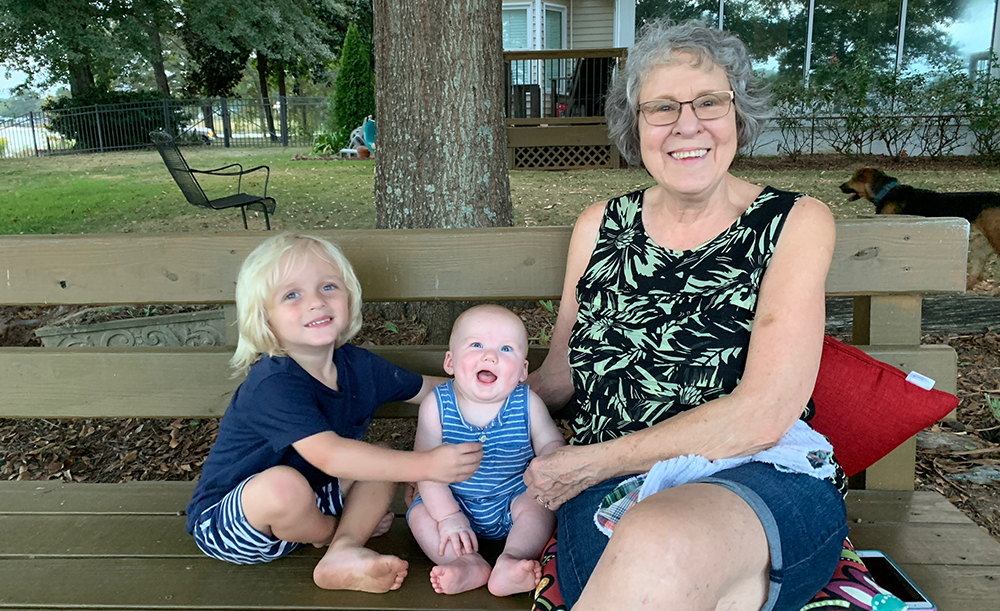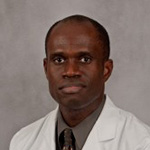 Norine Wilson plays with her grandchildren in the yard, an activity she is now able to do after receiving spine surgery from UAB neurosurgeon Dr. Mamerhi Okor in June 2017. (Photo courtesy of Norine Wilson)
Norine Wilson plays with her grandchildren in the yard, an activity she is now able to do after receiving spine surgery from UAB neurosurgeon Dr. Mamerhi Okor in June 2017. (Photo courtesy of Norine Wilson)
Norine Wilson says she’s never been the type to sit around and wait on anything. After living with chronic pain in her back and legs for more than a year and meeting with physicians who suggested only short-term treatments, she was ready for a real solution.
“They said to try an epidural, or a shot, that would work for a while, but I wasn’t looking for temporary fixes,” Wilson said. “I wanted something that was going to work.”
Wilson, 69, had already met with an orthopedist, a chiropractor and a spine specialist and had spent months in rehab for the pain before she was referred to Mamerhi Okor, M.D., an associate professor in the UAB Department of Neurosurgery, in May 2017.
“Pain kind of comes on gradually when you get older, so you don’t really know whether it’s something that can be fixed or you just need to rest more – whether you need to do more exercise or don’t need to do any exercise,” Wilson said. “But by the time that I got to see Dr. Okor, I already had it in my mind that I wanted a permanent fix.”
 Dr. Mamerhi Okor
Dr. Mamerhi Okor
Okor told Wilson that the epidural might only work for a few months at most but that the pain would eventually come back and that her best bet for a long-term solution was surgery.
“Ms. Wilson’s condition was the result of arthritic injury and age-related changes in the body, not any sort of trauma,” Okor said. “But she needed a lumbar fusion operation to lock down that joint between the bones in the spine to decompress the spinal canal.”
Okor said Wilson suffered from spondylolisthesis, a condition in which the vertebrae slip out of place, compressing the spine. This pressure eventually narrowed her spinal canal, causing spinal stenosis and the severe pain in her back and legs.
Wilson had done some research on this kind of spine surgery and lamented the long recovery times that many other patients had reported.
“If you go online and add yourself to these groups and read all of these horror stories, which is what I did, it’s scary,” she said. “I know doctors can’t guarantee anything, but Dr. Okor was really optimistic about everything and how the results should be. It really put me at ease after I had decided that I had to do something permanent.
“I just felt very comfortable with him, so we went ahead and scheduled the surgery and went that route.”
Okor performed Wilson’s surgery in June 2017, and although recovery was difficult, she avoided rehab altogether by getting up, moving around and just performing the daily tasks she had been doing before surgery, per Okor’s suggestion.
“You kind of have to do regular stuff around the house, like picking stuff up off the floor, or at least try to,” she said. “Just do your regular, day-to-day activities, and then you can make yourself well on your own, rather than sitting around and letting people wait on you. Someone who just sits around won’t get as well as fast.”
In less than a month, Wilson had completely weaned herself off of the pain medication she was prescribed and had regained some of her independence.
“The process of getting up to walk around, sitting up from a chair and getting up from a chair really was my rehab,” she said. “By three weeks, I was completely off my meds and able to drive, which was a big thing for me because I’m very independent and just wanted to get out of the house. I think that’s why I recovered so quickly, because I was determined to get better as quickly as I could.”
Within two months, Wilson said she was completely free of the pain that had plagued her for more than a year.
“You go from having pain all the time when you walk to not having pain at all in two months,” she said. “I’ve walked and carried on all my life, but it always hurt, all of the time. In two months’ time, I was completely pain free in my back and free from the pain down my leg, which is amazing.”
Okor lauded Wilson’s recovery, noting that her results were, by no means, atypical.
“She is on the good side of things,” Okor said. “Some people struggle to get better overall, but a majority of patients have meaningful symptom relief after the surgery. Ms. Wilson had excellent results from the surgery which have remained until today.”
After her surgery, Wilson left a review of her operation online and was soon contacted by someone else who was considering the same operation but who was afraid of a long recovery time.
“Older people like me like to hear or read that it’s not going to be that long to recover, that it’s not going to be six months to a year until you feel better,” she said. “But I know that a doctor can’t guarantee that, so it’s really hard to say that you’re going to be driving in three weeks and, in two months, you’re going to be back to normal, which is what happened to me.”
Wilson said she was happy to share her positive experience with someone in the same position she was in prior to meeting Dr. Okor at UAB because she understood the need to talk about surgery with someone who had gone through it before.
“I don’t know, but I think that it’s very important for people to know that the recovery time is not that bad if you put the effort in,” she said. “And people like the interaction of speaking to someone familiar with it – not just the doctor.”
The patient with whom Wilson had spoken took her advice and shared the positive results of her own surgery in October 2017.
“I had the best results that I could have had, so I would definitely recommend Dr. Okor and UAB,” Wilson said. “I mean, you’re dealing with pain for over a year, and for someone to walk in and tell you that they think they can make you better and that they think the pain will be gone right after surgery, it’s amazing.”